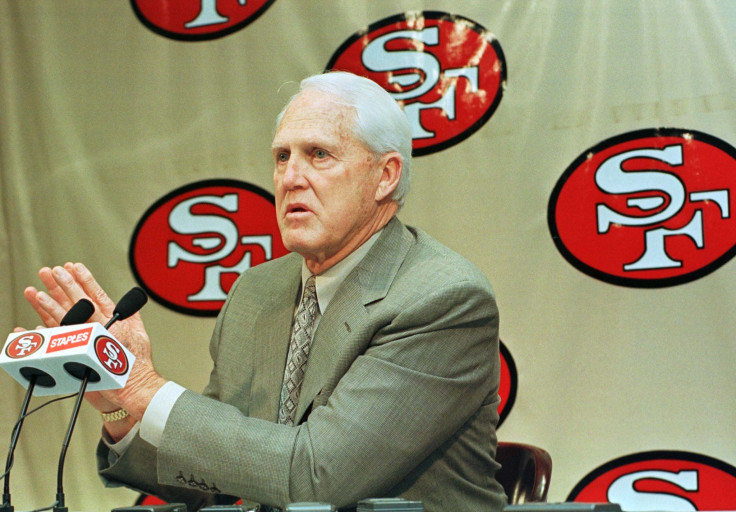NFL Playbook 2014: What Exactly Is The West Coast Offense, And How Does It Work?

In today’s NFL, the passing game has evolved into the preeminent weapon for head coaches and offensive coordinators, as evidenced by the ever inflating, record-breaking passing statistics and the precipitous decline of rushing stats over the last 10 years.
The most glaring stat is the number of pass attempts taken last season, but a more subtle and telling stat lies in the number of teams hopping on the passing bandwagon. In 2013, nine teams attempted 600 or more passes, and only four threw the ball less than 500 times. Inversely, starting in 2004, two teams attempted less than 400 passes, and 11 less than 500, with zero teams attempting 600 or more (Green Bay was close with 598 attempts). But since 2004, at least one team has heaved 600 or more passes, and 2005 was the last season any team attempted less than 400.
In 2005, 2006, 2008, and 2010, at least 10 teams fired up less than 500 passes, but in the last three seasons there has been a dip into the single digits, with six in 2011, eight in 2012 and the aforementioned four in 2013. And on 70 occasions since 2004, there has been a quarterback who has thrown for more than 4,000 yards in a single season.
As a result scoring is up big in the NFL, and while this seems like a rather recent phenomenon thanks to the league restricting defensive players and thus giving more freedom to receivers and providing better protection to quarterbacks, the origins of the passing game’s evolution start with Bill Walsh and the West Coast Offense.
The late Walsh was head coach of the San Francisco 49ers from 1979 to 1988, and was later a team executive and consultant from 1999 to 2004. But his influence on football and the number of current and former head coaches can still be measured today. Current NFL head coaches like Kansas City’s Andy Reid, Green Bay’s Mike McCarthy, Tampa Bay’s Lovie Smith, Baltimore’s John Harbaugh, Denver’s John Fox, Pittsburgh’s Mike Tomlin and Atlanta’s Mike Smith are all part of the elaborate branches that make up Walsh’s extensive coaching tree and influence on the game today.
Though the West Coast offense can be complicated, the basic tenets of the scheme involve a quarterback using quick short passes within 15 or 20 yards from the line of scrimmage for a higher completion rate. In theory, it also allows a receiver, running back, or tight end to come up with big chunks of yards after the catch, and sucks in a defense before unleashing a deeper play down field.
Typically, a team needs a mobile and accurate quarterback with excellent footwork, and works best with good route-running receivers and running backs in tandem with tight ends capable of blocking and getting to the middle of the field for short throws. A quarterback will usually get the ball out after a quick read and following a three or five-step drop back into the pocket.
With Hall of Fame quarterbacks Joe Montana and Steve Young, the 49ers used the West Coast Offense to win five Super Bowls under Walsh and his successor George Seifert from 1981 to 1994.
In today’s game, you’ll find coaches don’t explicitly use the West Coast Offense the same way Walsh conjured it up almost 40 years ago, but rather find ways to fine tune it to their personnel.
The defending Super Bowl champion Seattle Seahawks, thanks to offensive coordinator Darren Bevell, used the West Coast schemes. But Bevell noted to the Seattle Times back in January before capturing the Super Bowl that he’s tailored Seattle’s attack to his receivers like Percy Harvin and running back Marshawn Lynch.
"Really there is so much more that has to go into it because you need to know who you have, who your tight ends are, who your receivers are, who your running back is,” Bevell said. “And you have to develop it from what is best for those guys. So we change a lot. I think we are probably more of a down-the-field, trying-t0-be-explosive team than some West Coast teams. A little bit more quick-timing rhythm throws. So we have kinid of evolved that way.”
Back in 2012 there were rumblings around the NFL that the West Coast Offense was slowly dying out. As broken down by USA Today, teams that were known for power-running schemes complemented by punishing, grinding defenses like the Baltimore Ravens were instead taking advantage of the NFL’s new wave of rules restricting defensive players with big-armed quarterbacks like Joe Flacco running no-huddle, vertical passing schemes to put up huge numbers.
But there are still teams reinventing and tinkering with the West Coast schemes. Another traditionally rush and defense-first team like the New York Giants, who floundered last season under star quarterback Eli Manning, hired former Green Bay quarterbacks and tight ends coach Ben McAdoo to implement the West Coast Offense. Thus far, Manning has struggled with the adjustments to his footwork, but he and the rest of the Giants are hoping to make the offense work.
“We’ve got to get to the point where all of these things are second nature,” Manning said to the New York Times. “And that takes a little time and a little patience.”
© Copyright IBTimes 2024. All rights reserved.





















